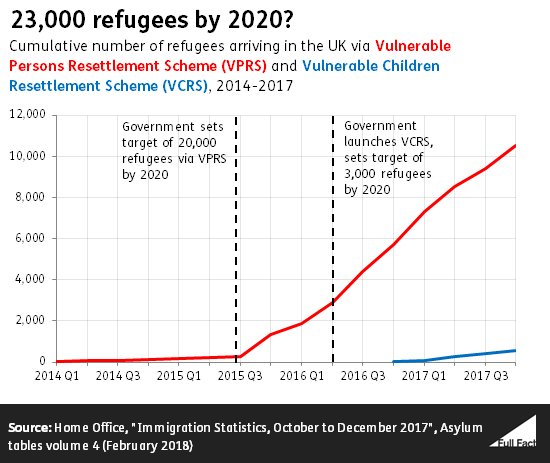The government has said it aims to resettle 23,000 refugees in the UK from Syria and the surrounding region by 2020. So far, just over 11,000 refugees have come under two resettlement schemes, the first of which began in earnest in September 2015.
Prior to July 2017, those arriving on the scheme didn’t technically have refugee status in the UK, and instead had “Humanitarian Protection”. This gives individuals the right to five years’ residence in the UK, but not the full range of rights (such as access to benefits and support for Higher Education) that someone with refugee status has.
Of the 23,000 target, 20,000 are specifically from the conflict in Syria. The other 3,000 are vulnerable children and their families in the Middle East and North Africa.
These schemes aren’t the only way for refugees to enter the UK. Another 8,000 Syrian asylum seekers have been granted asylum after applying in the UK since 2011.
The Home Secretary yesterday claimed that the the government is “slightly ahead of schedule” in meeting the target to resettle 20,000 refugees from the Syrian conflict by 2020. This seems to be based on just over half of the target number having been resettled in roughly half the time since the target was set.
Some on the scheme don’t have refugee status
The Home Office told us that everyone who arrives via the government schemes fits the UN’s definition of a refugee.
But not all these people were granted refugee status by the UK. Prior to July 2017, they were granted Humanitarian Protection and five years’ stay in the UK. The government summarised the difference in status:
“while Humanitarian Protection recognises the need an individual has for international protection, it does not carry the same entitlements as refugee status, in particular, access to particular benefits, swifter access to student support for Higher Education and the same travel documents as those granted refugee status.”
Since July 2017, individuals on the scheme have been granted refugee status and five years’ stay in the UK. Those who arrived before that date may request a change to refugee status. Refugees in the UK normally get a residence permit for five years, after which they may apply for permanent residence.
For the rest of this piece, we will refer to all people arriving via a government resettlement scheme as a “refugee”.
What was the target?
The UK has two different resettlement schemes specifically for refugees from Syria and the surrounding region. Together, these two schemes aim to take in 23,000 people by 2020. Not all of these will necessarily be from Syria, though.
In September 2015, then-Prime Minister David Cameron announced “that Britain should resettle up to 20,000 Syrian refugees over the rest of this Parliament”.
The commitment to resettling 20,000 refugees by 2020 expanded the ambitions of the existing Syrian Vulnerable Persons Resettlement Scheme (VPRS). Launched in January 2014 to help Syrian refugees, the VPRS had resettled 252 refugees between then and October 2015.
The scheme is meant to to identify, with the help of the United Nations High Commissioner for Refugees (UNHCR), “those most at risk and bring them to the UK”. It does not cover Syrian refugees already in Europe.
Since July 2017, refugees of any nationality fleeing the conflict in Syria may be considered for the VPRS.
The government announced a second resettlement scheme in April 2016. It aims to bring 3,000 vulnerable and refugee children and their families from the Middle East and North Africa to the UK by 2020. Now called the Vulnerable Children's Resettlement Scheme (VCRS), it covers unaccompanied and separated children, as well as “other vulnerable children such as child carers and those facing the risk of child labour, child marriage or other forms of neglect, abuse or exploitation.”
Those arriving through both schemes are granted five years’ stay in the UK.
These schemes are not the only way enter the UK as a refugee. An individual may apply to the UK as an asylum seeker. An asylum seeker will then have their case considered by the government, to determine whether or not they are a refugee under international law.
What has happened so far?
Government figures released yesterday show that, by December 2017, roughly 10,500 refugees from the Syrian conflict have been resettled under the VPRS. The vast majority were resettled since September 2015. Almost 5,000 were resettled in 2017, and roughly half of them were children.
570 people have been resettled under the VCRS, 539 of whom were in 2017.
In addition to this, over 8,000 Syrian asylum seekers and their dependants were accepted refugges in the UK from 2011 to 2017. This means they applied for protection in the UK, rather than having been identified through a government scheme. Overall there were an estimated 119,000 refugees in the UK at the end of 2016, according to the UN.
Globally, there are 5.6 million refugees from Syria. 3.5 million are registered in Turkey, and a further two million are in Egypt, Iraq, Jordan, and Lebanon according to the UNHCR. 63% of Syrian asylum applications in Europe were made to Germany or Sweden between April 2011 and December 2017.
Ahead of schedule?
The Home Secretary yesterday claimed that the government is “slightly ahead of schedule” in meeting the 20,000 target. We asked the Home Office for more information on this but they didn’t provide any further detail.
Just over 10,000 refugees have arrived in the UK via VPRS, based on figures up to December 2017. The target was set in September 2015, with an end-date of 2020—so just over half the target has been met in roughly half the allotted time period. We don’t know if the pace of resettlement is expected to be the same across the whole period to 2020.
